cooling Acura Integra 2000 Hatchback User Guide
[x] Cancel search | Manufacturer: ACURA, Model Year: 2000, Model line: Integra, Model: Acura Integra 2000Pages: 279, PDF Size: 3.57 MB
Page 180 of 279
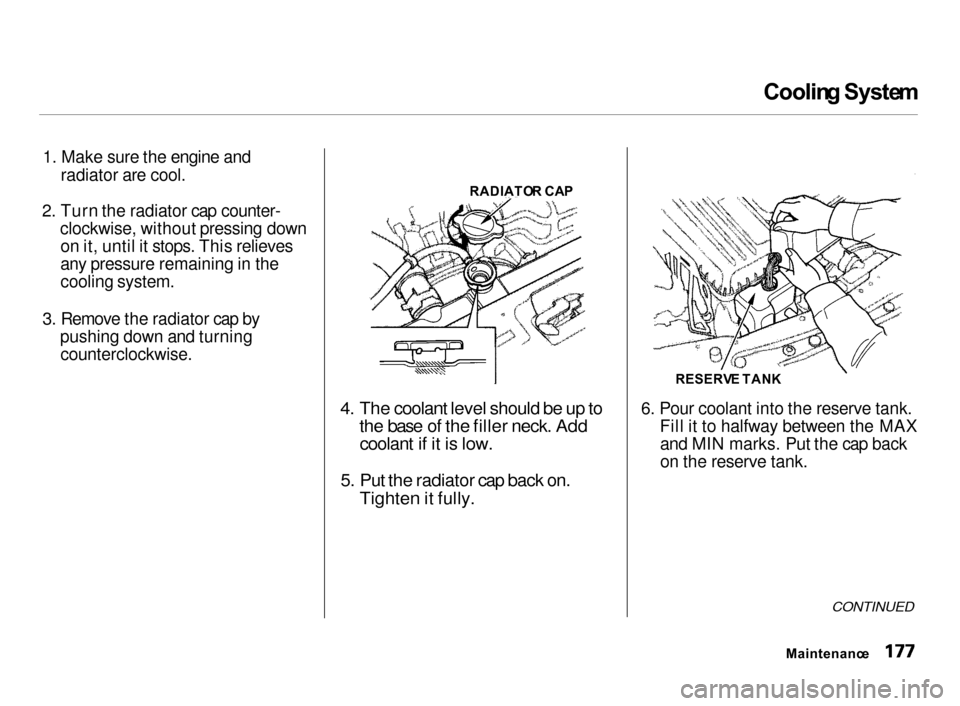
Coolin
g Syste m
1. Make sure the engine and
radiator are cool.
2. Turn the radiator cap counter-
clockwise, without pressing down on it, until it stops. This relieves
any pressure remaining in the
cooling system.
3. Remove the radiator cap by
pushing down and turningcounterclockwise.
4. The coolant level should be up to
the base of the filler neck. Add
coolant if it is low.
5. Put the radiator cap back on.
Tighten it fully.
6. Pour coolant into the reserve tank.
Fill it to halfway between the MAXand MIN marks. Put the cap back
on the reserve tank.
CONTINUED
Maintenanc e
RESERV
E TAN K
RADIATO
R CA P
Page 181 of 279
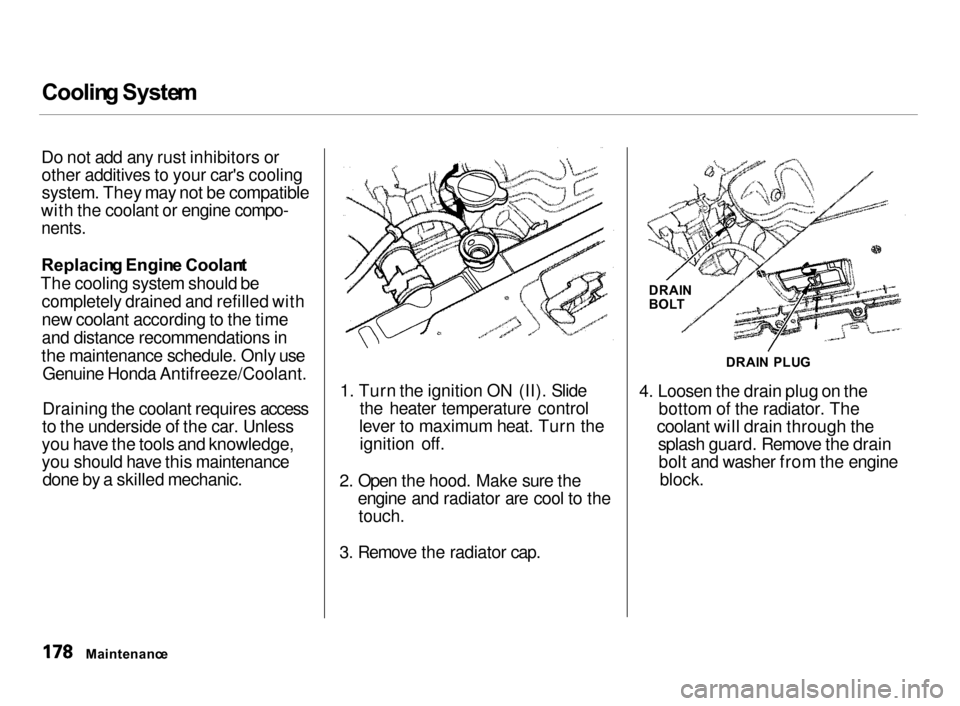
Coolin
g Syste m
Do not add any rust inhibitors or other additives to your car's cooling
system. They may not be compatible
with the coolant or engine compo-
nents.
Replacin g Engin e Coolan t
The cooling system should be completely drained and refilled with
new coolant according to the time
and distance recommendations in
the maintenance schedule. Only use Genuine Honda Antifreeze/Coolant.
Draining the coolant requires access
to the underside of the car. Unless
you have the tools and knowledge,
you should have this maintenance done by a skilled mechanic. 1. Turn the ignition ON (II). Slidethe heater temperature control
lever to maximum heat. Turn the ignition off.
2. Open the hood. Make sure the
engine and radiator are cool to the touch.
3. Remove the radiator cap. 4. Loosen the drain plug on the
bottom of the radiator. The
coolant will drain through the splash guard. Remove the drainbolt and washer from the engine block.
Maintenanc e DRAI
N PLU G
DRAI
N
BOL T
Page 182 of 279
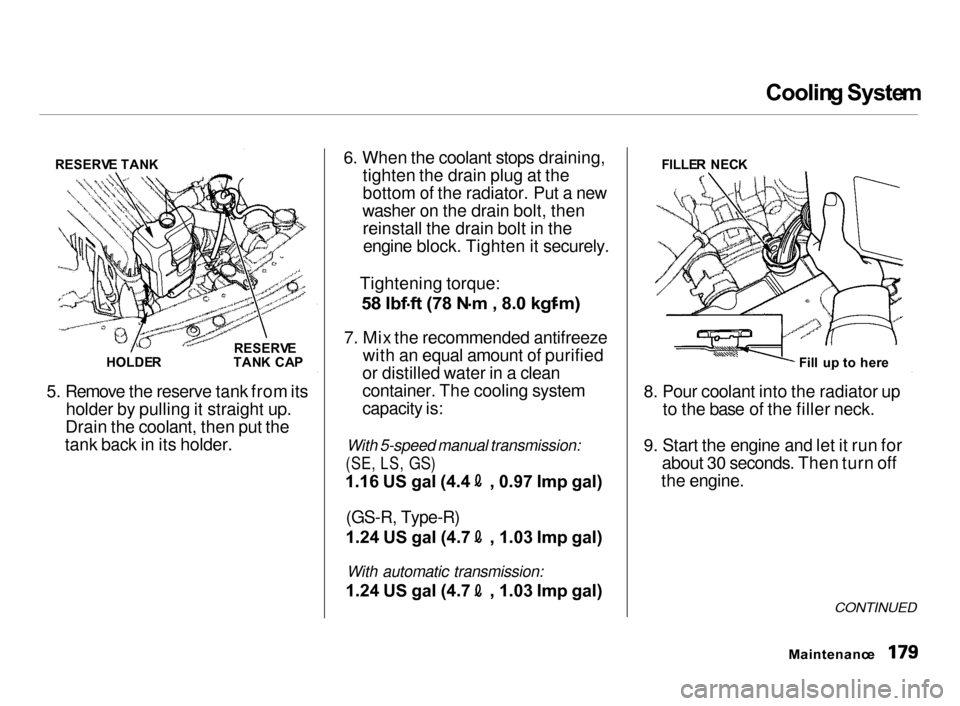
Coolin
g Syste m
5. Remove the reserve tank from itsholder by pulling it straight up.
Drain the coolant, then put the
tank back in its holder.
6. When the coolant stops draining,
tighten the drain plug at the
bottom of the radiator. Put a new
washer on the drain bolt, then reinstall the drain bolt in theengine block. Tighten it securely.
Tightening torque:
58 Ibf .
ft (78 N .
m , 8.0 kgf .
m)
7. Mix the recommended antifreeze
with an equal amount of purified
or distilled water in a clean
container. The cooling system
capacity is:
With 5-speed manual transmission:
(SE,
LS,
GS)
1.16 US gal (4.4 , 0.97 Imp gal)
(GS-R, Type-R)
1.24 US gal (4.7 , 1.03 Imp gal)
With automatic transmission:
1.24 US gal (4.7 , 1.03 Imp gal)
8. Pour coolant into the radiator up
to the base of the filler neck.
9. Start the engine and let it run for
about 30 seconds. Then turn off
the engine.
CONTINUED
Maintenanc e
HOLDE
R RESERV
E
TAN K CA P
RESERV
E TAN K
Fill u p t o her e
FILLE
R NEC K
Page 183 of 279
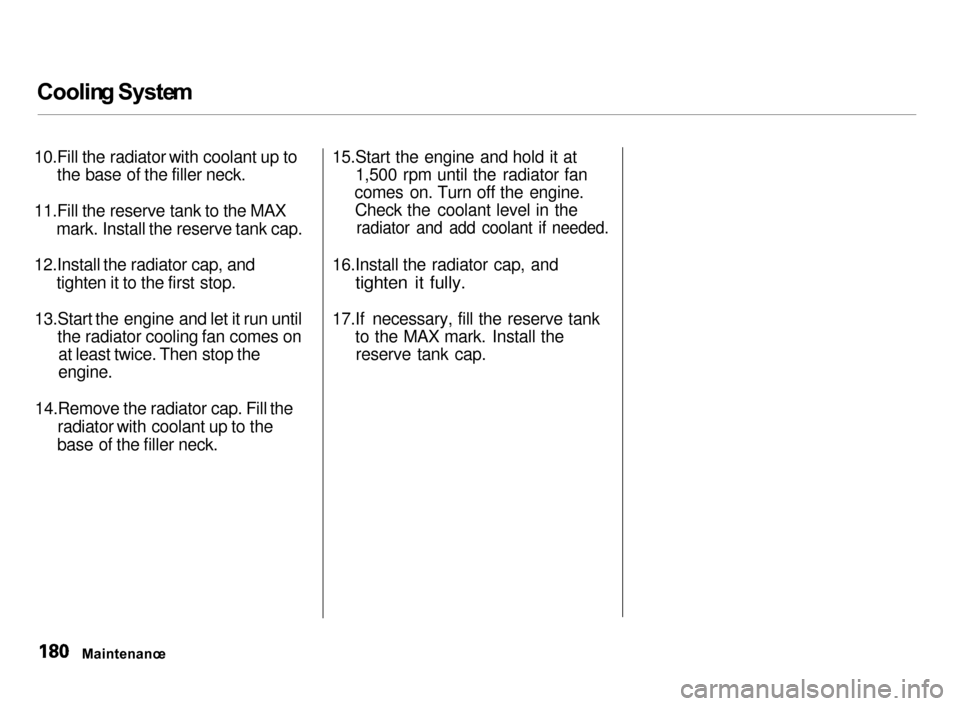
Coolin
g Syste m
10.Fill the radiator with coolant up to
the base of the filler neck.
11.Fill the reserve tank to the MAX
mark. Install the reserve tank cap.
12.Install the radiator cap, and
tighten it to the first stop.
13.Start the engine and let it run until
the radiator cooling fan comes on at least twice. Then stop the
engine.
14.Remove the radiator cap. Fill the
radiator with coolant up to the
base of the filler neck.
15.Start the engine and hold it at
1,500 rpm until the radiator fan
comes on. Turn off the engine. Check the coolant level in the
radiator and add coolant if needed.
16.Install the radiator cap, and
tighten it fully.
17.If necessary, fill the reserve tank
to the MAX mark. Install thereserve tank cap.
Maintenanc e
Page 197 of 279
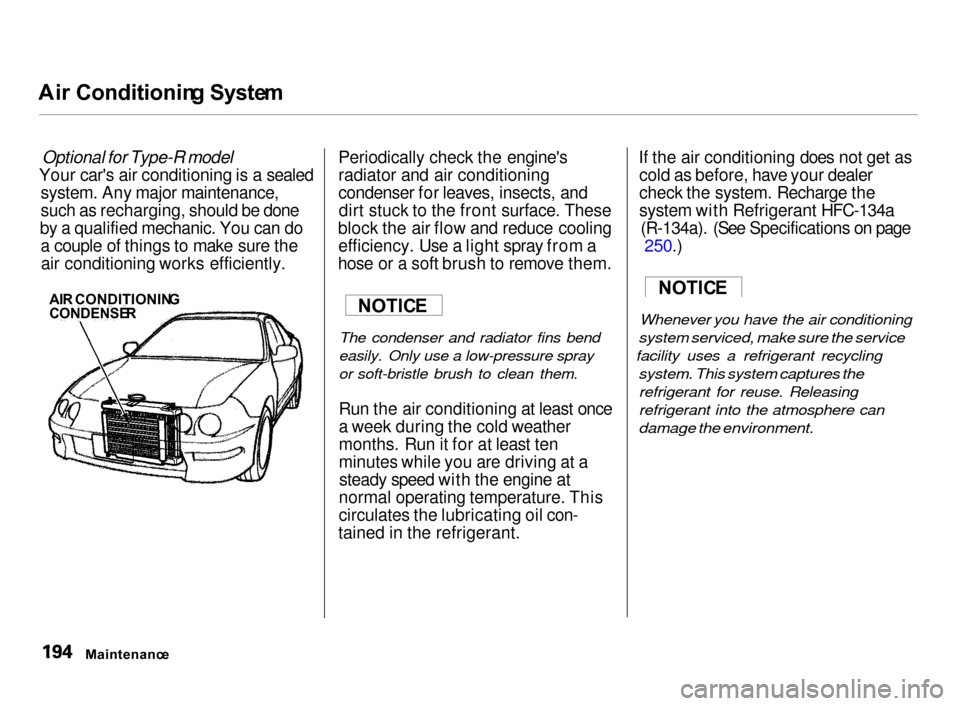
Ai
r Conditionin g Syste m
Optional for Type-R model
Your car's air conditioning is a sealed system. Any major maintenance,
such as recharging, should be done
by a qualified mechanic. You can do a couple of things to make sure theair conditioning works efficiently. Periodically check the engine's
radiator and air conditioning
condenser for leaves, insects, and
dirt stuck to the front surface. These
block the air flow and reduce cooling efficiency. Use a light spray from a
hose or a soft brush to remove them.
The condenser and radiator fins bend
easily. Only use a low-pressure spray
or soft-bristle brush to clean them.
Run the air conditioning at least once
a week during the cold weather
months. Run it for at least ten
minutes while you are driving at a steady speed with the engine at
normal operating temperature. This
circulates the lubricating oil con-
tained in the refrigerant. If the air conditioning does not get as
cold as before, have your dealer
check the system. Recharge the
system with Refrigerant HFC-134a (R-134a). (See Specifications on page 250.)
Whenever you have the air conditioning
system serviced, make sure the service
facility uses a refrigerant recycling
system. This system captures the
refrigerant for reuse. Releasing
refrigerant into the atmosphere can
damage the environment.
Maintenanc e
AI
R CONDITIONIN G
CONDENSE R
NOTIC
E NOTIC
E
Page 236 of 279
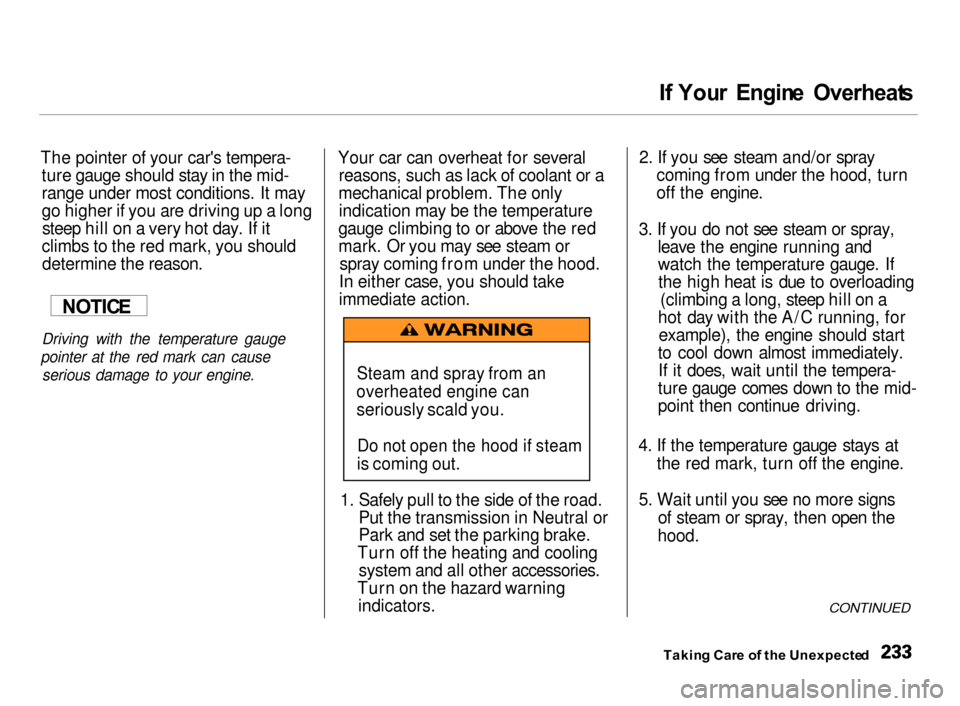
I
f You r Engin e Overheat s
The pointer of your car's tempera- ture gauge should stay in the mid-
range under most conditions. It may
go higher if you are driving up a longsteep hill on a very hot day. If it
climbs to the red mark, you should determine the reason.
Driving with the temperature gauge
pointer at the red mark can cause serious damage to your engine. Your car can overheat for several
reasons, such as lack of coolant or a
mechanical problem. The only indication may be the temperature
gauge climbing to or above the red
mark. Or you may see steam or spray coming from under the hood.
In either case, you should take
immediate action.
1. Safely pull to the side of the road.
Put the transmission in Neutral or
Park and set the parking brake.
Turn off the heating and cooling system and all other accessories.
Turn on the hazard warning indicators.
2. If you see steam and/or spray
coming from under the hood, turn
off the engine.
3. If you do not see steam or spray,
leave the engine running and
watch the temperature gauge. If the high heat is due to overloading (climbing a long, steep hill on a
hot day with the A/C running, for example), the engine should start
to cool down almost immediately. If it does, wait until the tempera-
ture gauge comes down to the mid-
point then continue driving.
4. If the temperature gauge stays at
the red mark, turn off the engine.
5. Wait until you see no more signs
of steam or spray, then open the
hood.
CONTINUED
Takin g Car e o f th e Unexpecte d
NOTIC
E
Steam and spray from an
overheated engine can
seriously scald you.
Do not open the hood if steam
is coming out.
Page 237 of 279
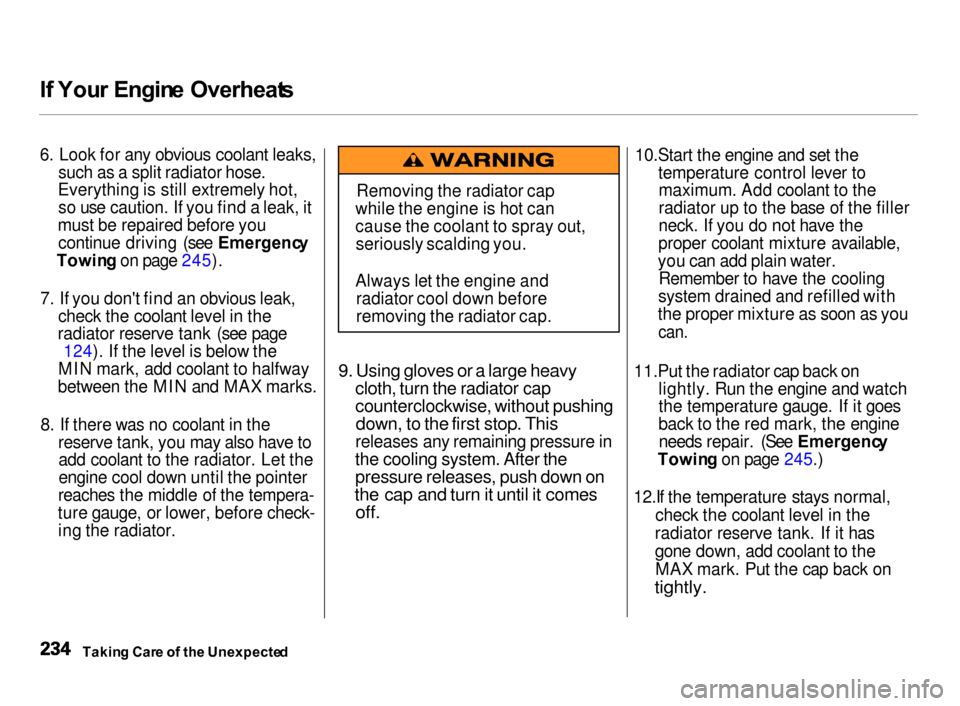
I
f You r Engin e Overheat s
6. Look for any obvious coolant leaks,
such as a split radiator hose.
Everything is still extremely hot, so use caution. If you find a leak, it
must be repaired before you continue driving (see Emergenc y
Towin g on page 245).
7. If you don't find an obvious leak,
check the coolant level in the
radiator reserve tank (see page 124). If the level is below the
MIN mark, add coolant to halfway
between the MIN and MAX marks.
8. If there was no coolant in the
reserve tank, you may also have to add coolant to the radiator. Let the
engine cool down until the pointer
reaches the middle of the tempera-
ture gauge, or lower, before check- ing the radiator.
9. Using gloves or a large heavy
cloth, turn the radiator cap
counterclockwise, without pushing
down, to the first stop. This
releases any remaining pressure in
the cooling system. After the
pressure releases, push down on
the cap and turn it until it comes
off.
10.Start the engine and set the
temperature control lever to
maximum. Add coolant to the
radiator up to the base of the filler
neck. If you do not have the
proper coolant mixture available,
you can add plain water. Remember to have the cooling
system drained and refilled with
the proper mixture as soon as you
can.
11.Put the radiator cap back on
lightly. Run the engine and watch
the temperature gauge. If it goes
back to the red mark, the engine needs repair. (See Emergenc y
Towin g on page 245.)
12.If the temperature stays normal,
check the coolant level in the
radiator reserve tank. If it has
gone down, add coolant to the MAX mark. Put the cap back on
tightly.
Takin g Car e o f th e Unexpecte d
Removing the radiator cap
while the engine is hot can
cause the coolant to spray out, seriously scalding you.
Always let the engine and radiator cool down before
removing the radiator cap.
Page 274 of 279
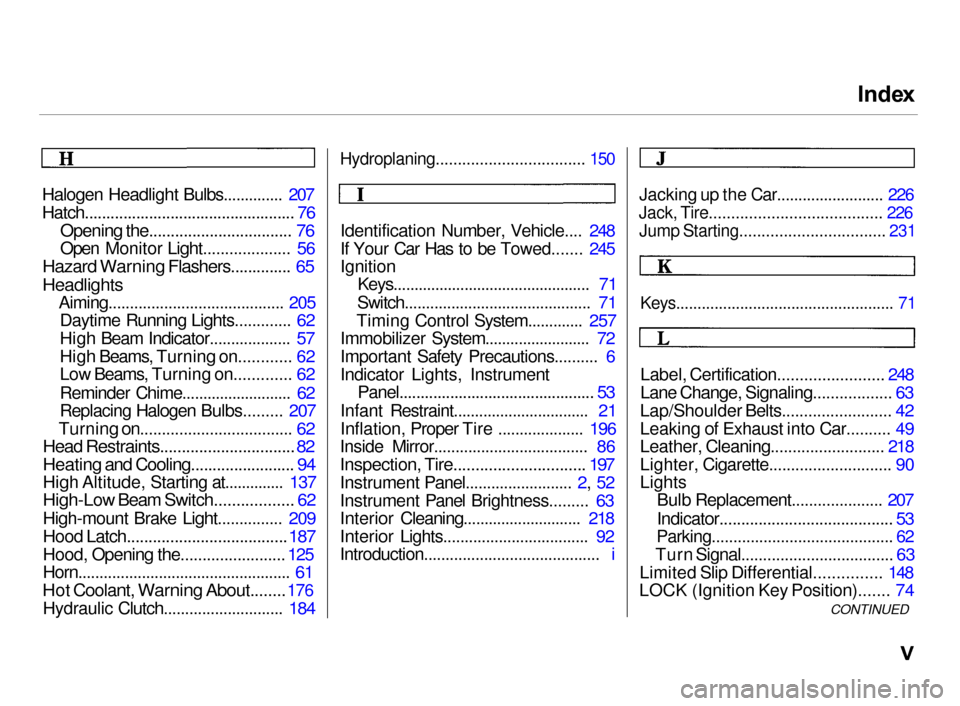
Inde
x
Halogen Headlight Bulbs.............. 207
Hatch................................................. 76
Opening the................................. 76
Open Monitor Light.................... 56
Hazard Warning Flashers.............. 65
Headlights
Aiming......................................... 205Daytime Running Lights............. 62
High Beam Indicator................... 57
High Beams, Turning on............ 62
Low Beams, Turning on............. 62
Reminder Chime.......................... 62
Replacing Halogen Bulbs......... 207
Turning on................................... 62
Head Restraints...............................
82
Heating and Cooling........................ 94
High Altitude, Starting at.............. 137
High-Low Beam Switch.................. 62
High-mount Brake Light............... 209
Hood Latch.....................................
187
Hood, Opening the........................
125
Horn..................................................
61
Hot Coolant, Warning About........
176
Hydraulic Clutch............................ 184
Hydroplaning.................................. 150
Identification Number, Vehicle.... 248
If Your Car Has to be Towed....... 245
Ignition Keys............................................... 71
Switch............................................ 71
Timing Control System............. 257
Immobilizer System......................... 72
Important Safety Precautions.......... 6
Indicator Lights, Instrument
Panel.............................................. 53
Infant Restraint................................ 21
Inflation, Proper Tire .................... 196
Inside Mirror.................................... 86
Inspection, Tire.............................. 197
Instrument Panel......................... 2, 52
Instrument Panel Brightness......... 63
Interior Cleaning............................ 218
Interior Lights.................................. 92
Introduction......................................... i
Jacking up the Car......................... 226
Jack, Tire....................................... 226
Jump Starting................................. 231
Keys................................................... 71
Label, Certification........................ 248
Lane Change, Signaling.................. 63
Lap/Shoulder Belts......................... 42
Leaking of Exhaust into Car.......... 49
Leather, Cleaning.......................... 218
Lighter, Cigarette............................ 90
Lights Bulb Replacement..................... 207
Indicator........................................ 53
Parking.......................................... 62
Turn Signal................................... 63
Limited Slip Differential............... 148
LOCK (Ignition Key Position)....... 74
CONTINUED